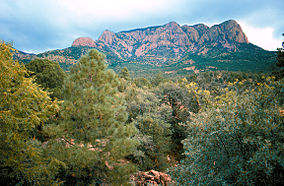
Back غابة سيبولا الوطنيه ARZ Cibola National Forest CEB Cibola National Forest German Forêt nationale de Cibola French Cibola National Forest Swedish 西波拉国家森林 Chinese
| Cibola National Forest | |
|---|---|
 The Apache Kid Wilderness in the Cibola National Forest. Photo: US Forest Service. | |
| Location | New Mexico, United States |
| Nearest city | Albuquerque, New Mexico |
| Coordinates | 34°17′49″N 107°24′47″W / 34.297°N 107.413°W |
| Area | 1,633,783 acres (6,611.69 km2)[1] |
| Established | December 3, 1931[2] |
| Governing body | U.S. Forest Service |
| Website | Cibola National Forest |
The Cibola National Forest (pronounced SEE-bo-lah) is a 1,633,783 acre (6,611.7 km2) United States National Forest in New Mexico, US. The name Cibola is thought to be the original Zuni Indian name for their pueblos or tribal lands. The name was later interpreted by the Spanish to mean "buffalo".[3] The forest is disjointed with lands spread across central and northern New Mexico, west Texas and Oklahoma. The Cibola National Forest is divided into four Ranger Districts: the Sandia, Mountainair, Mt. Taylor, and Magdalena. The Forest includes the San Mateo, Magdalena, Datil, Bear, Gallina, Manzano, Sandia, Mt. Taylor, and Zuni Mountains of west-central New Mexico. The Forest also manages four National Grasslands that stretch from northeastern New Mexico eastward into the Texas Panhandle and western Oklahoma. The Cibola National Forest and Grassland is administered by Region 3 of the United States Forest Service from offices in Albuquerque, New Mexico. Elevation ranges from 5,000 ft (1,500 m) to 11,301 ft (3,445 m). (The preceding figures do not include any of the four National Grasslands mentioned below, which are detailed in their individual articles.) The descending order of Cibola National Forest acres (not counting the three Grassland areas) by county are: Socorro, Cibola, McKinley, Catron, Torrance, Bernalillo, Sandoval County, New Mexico, Lincoln, Sierra, and Valencia counties in New Mexico. The Cibola National Forest currently has 137,701 acres designated as Wilderness. In addition to these acres, it has 246,000 acres classified as Inventoried Roadless Areas pursuant to the Roadless Area Conservation Rule.[4]
The Cibola National Forest is organized into several divisions over three states. The Rita Blanca National Grassland 92,989 acres (376.3 km2) in Dallam County, Texas, and Cimarron County, Oklahoma, Black Kettle National Grassland 31,286 acres (126.6 km2) in Roger Mills County, Oklahoma, and Hemphill County, Texas, and McClellan Creek National Grassland 1,449 acres (5.9 km2) in Gray County, Texas, are in the Oklahoma–Texas panhandle region. The combined Cibola National Grasslands are 262,141 acres (1,060.8 km2) in size.
New Mexico is home to much of the Forest, including the Kiowa National Grassland 136,417 acres (552.1 km2) in Harding, Union, Mora, and Colfax counties, New Mexico. The Cibola National Forest's Sandia Ranger District is just east of Albuquerque in Central New Mexico and includes the most visited mountains in the state of New Mexico. The Sandia District includes national forest land in eastern Bernalillo and southeastern Sandoval counties, and includes the Sandia Peak Tram and the Sandia Crest National Scenic Byway. The Sandia Mountains lie in the northern portion of the District. It is here where Congress designated the Sandia Mountain Wilderness (37,200 acres) in 1978. The Cibola's Sandia Ranger District also includes the Manzanita Mountains, which stretch south, between the Sandia and the Manzano Mountains. The Manzano Mountains are managed by the Cibola National Forest's Mountainair Ranger District.[5]

The Mountainair Ranger District manages national forestland in Torrance, northwestern Lincoln, and eastern Valencia counties, which are in central New Mexico. Within the Mountainair District are the Gallinas Mountains and the Manzano Mountains. Congress designated the Manzano Wilderness in 1978. The Mount Taylor Ranger District manages land in northern Cibola, southern McKinley, and western Sandoval counties in western New Mexico. Mount Taylor and Zuni Mountains are within the Mount Taylor District.
Overseeing approximately 800,000 acres, the Magdalena Ranger District is the largest of the Cibola National Forest's four mountain districts. The Cibola’s Magdalena District manages land in south central New Mexico in western Socorro, northeastern Catron, and northern Sierra counties. The Bear Mountains, Datil Mountains, Magdalena Mountains and San Mateo Mountains are all within the Magdalena District. There are two Wilderness areas in this District – the Apache Kid (44,626 acres) and the Withington (19,000 acres) Wilderness areas, both of which are in the San Mateo Mountains. In addition to the designated Wilderness, the Magdalena Ranger District has 205,972 acres of Inventoried Roadless Areas. The Magdalena Ranger District's officers are stationed in the Village of Magdalena. The District has roots in the Gila Forest Reserve, created by President William McKinley in 1899, making the U.S. Forest Service the “oldest continuous business in Magdalena.”[6]
- ^ "Land Areas of the National Forest System" (PDF). U.S. Forest Service. January 2012. Retrieved June 26, 2012.
- ^ "The National Forests of the United States" (PDF). ForestHistory.org. Archived from the original (PDF) on October 28, 2012. Retrieved July 26, 2012.
- ^ Cibola National Forest and Grasslands. "About the Forest". US Forest Service.
- ^ Final EIS for the Roadless Area Conservation Rule, Volume 2 (PDF). US Forest Service.
- ^ Cibola National Forest. "Sandia Ranger District".
- ^ Cibola National Forest. "Magdalena Ranger District".
© MMXXIII Rich X Search. We shall prevail. All rights reserved. Rich X Search


